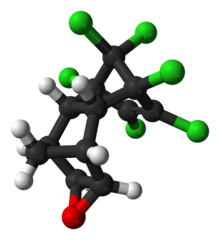Endrin
Appearance

| ||

| ||
| Names | ||
|---|---|---|
| IUPAC name
(1R,2S,3R,6S,7R,8S,9S,11R)-3,4,5,6,13,13-Hexachloro-10-oxapentacyclo[6.3.1.13,6.02,7.09,11]tridec-4-ene
| ||
| Other names
Mendrin, Compound 269, (1aR,2S,2aS,3S,6R,6aR,7R,7aS)-3,4,5,6,9,9-hexachloro-1a,2,2a,3,6,6a,7,7a-octahydro-2,7:3,6-dimethanonaphtho[2,3-b]oxirene, 1,2,3,4,10,10-Hexachloro-6,7-epoxy-1,4,4a,5,6,7,8,8a-octahydro-1,4-endo,endo-5,8-dimethanonaphthalene
| ||
| Identifiers | ||
3D model (JSmol)
|
||
| ChEBI | ||
| ChEMBL | ||
| ChemSpider | ||
| ECHA InfoCard | 100.000.705 | |
| EC Number |
| |
| KEGG | ||
PubChem CID
|
||
| RTECS number |
| |
| UNII | ||
| UN number | 2761 | |
CompTox Dashboard (EPA)
|
||
| ||
| Properties | ||
| C12H8Cl6O | ||
| Molar mass | 380.907 g/mol | |
| Appearance | Colorless to tan crystalline solid | |
| Density | 1.77 g/cm3 [1] | |
| Melting point | 200 °C (392 °F; 473 K) (decomposes) | |
| 0.23 mg/L[2] | ||
| Vapor pressure | 2.6 x 10-5 Pa[1] | |
| Hazards | ||
| NFPA 704 |
| |
| Flash point | noncombustible | |
| U.S. Permissible exposure limit (PEL) |
TWA 0.1 mg/m3 [skin][3] | |
Except where otherwise noted, data are given for materials in their standard state (at 25 °C [77 °F], 100 kPa). | ||
| Infobox references | ||
Endrin is an insecticide that was commonplace among cotton growers and for the treament of cereals. It was also used to kill rodents. It is a neurotoxin. It is a stereoisomer of Dieldrin. In the soil, it can take up to twelve years to decay. It is one of the twelve substances listed in the Stockholm Convention on Persistent Organic Pollutants, and its production, trade and use is banned since 2004.
References
[change | change source]- ↑ 1.0 1.1 "Endrin". Deutsche Gesellschaft für Technische Zusammenarbeit. Retrieved 13 March 2015.
- ↑ "Endrin (PDS)". IPCS. Archived from the original on 2 July 2014. Retrieved 13 March 2015.
- ↑ NIOSH Pocket Guide to Chemical Hazards. "#0252". National Institute for Occupational Safety and Health (NIOSH).

